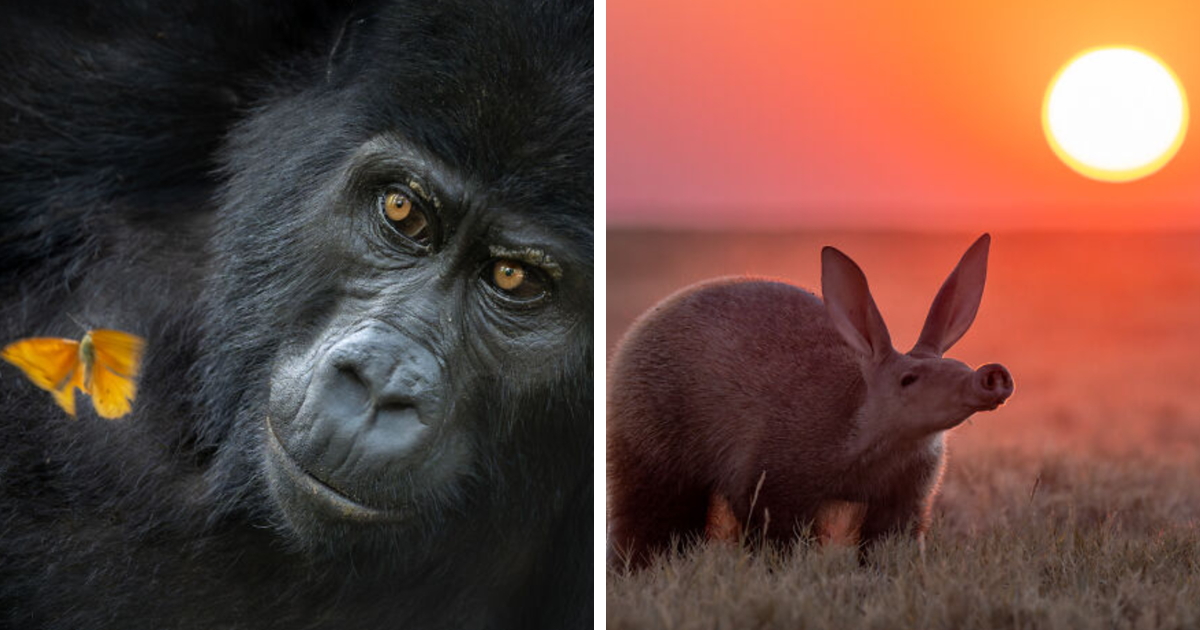
The Nature Photographer Of The Year: 20 Unforgettable Shots That Stood Out In 2025
The Nature Photographer of the Year (NPOTY) 2025 competition has unveiled a breathtaking collection of images that showcase the raw, delicate, and often surprising beauty of our natural world. Out of nearly 24,781 submissions from 96 countries, the judges selected the most evocative, technically impressive, and emotionally resonant photographs across a dozen categories.
Whether you’re a photographer, a nature lover, or someone who simply wants to pause and appreciate the wild, this year’s winners are a reminder: nature is not just a backdrop. It’s a story, and these photographers have helped tell it. While we can’t showcase all of them here, below is a curated exploration of some of the most powerful and memorable images from this year’s winners and runners-up, along with context on what makes them so compelling.
More info: naturephotographeroftheyear.com | Instagram | Facebook
#1 Category Landscape | Highly Commended: “Infernal Beauty” By Jason Mirandi, United States Of America
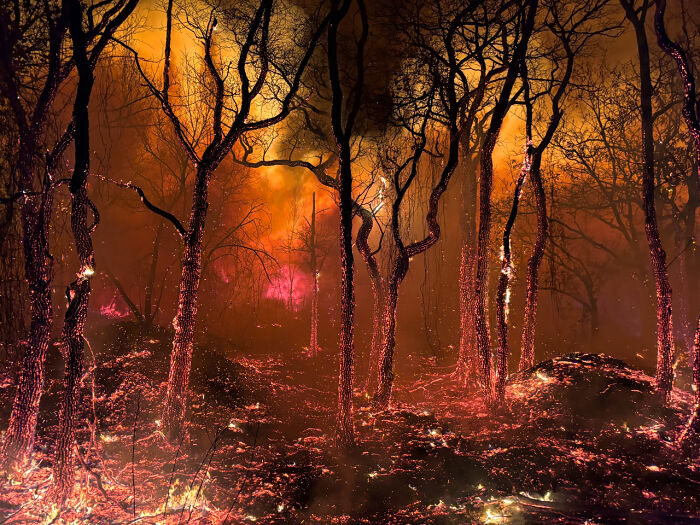
Image source: © Jason Mirandi | NPOTY 2025
“This image was created in November 2024 in Pennsylvania during the Lehigh Gap Fire. A wildfire that scorched 600 acres of the Blue Mountain near the Lehigh Water Gap in the eastern part of the state. Photography is a passion of mine, and so is firefighting, and when I had the opportunity to both battle this wildfire and document it for the world to see, I took it.
The image depicts the aftermath of a backburn, an intentionally set fire used to consume fuel between a firebreak and an oncoming, uncontrolled flame front, stopping its advance. While the raw flames of an active fire are powerful and dramatic, I purposely sought out the right scene and waited until the flame front had passed deeper into the forest to capture this photograph. In doing so, I hoped to reveal an entirely different, mesmerizing mood. The transformative power of fire is on full display in the aftermath of the retreating flame front, as the glowing, ember-covered trunks and gnarled branches create a landscape of haunting beauty that draws the viewer into the scene.
This fire occurred during a historic drought, the first month in 153 years of recorded history with zero rainfall in the Philadelphia region and much of the northeastern United States. While extreme fire behavior is often associated with the arid western states, drought conditions can fuel intense wildfires across broader regions, affecting areas not accustomed to or prepared for such explosive events. It’s a sobering reminder of nature’s raw power, and of our shared responsibility to respect and protect it.”
#2 Category Animals Portraits | Highly Commended: “Lioness Eyes Behind Birds” By Willem Kruger, South Africa
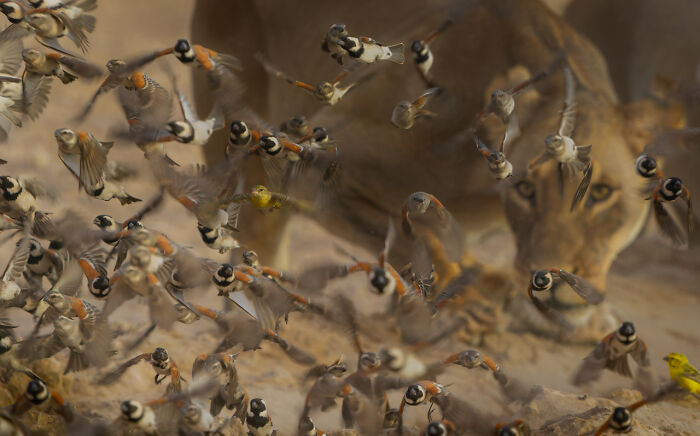
Image source: © Willem Kruger | NPOTY 2025
“I have the privilege of visiting the Kgalagadi Transfrontier Park several times a year. The park lies in a semi-arid environment and can sometimes be very dry, with only a few thundershowers each year. When this image was taken, it was during a very dry season in the Kgalagadi Transfrontier Park. As a result, we saw several small birds arriving in flocks at the waterhole to drink.
We were very fortunate one early morning when a pride of lions approached the waterhole while we were parked nearby. As the lions moved closer, the birds continued to arrive in flocks, landing briefly on the edge of the water before taking off again. In the photograph, a flock of small birds takes flight while one of the lionesses drinks. The lioness kept a watchful eye on the birds, as lions are natural hunters and anything that moves interests them. However, she made no attempt to catch or chase them away.
It was fascinating to watch the birds face potential danger while trying to drink, with a lioness so close by in the dry, semi-arid park. As always, the lioness remained alert, ready to react to any movement, as seen in her attentive behaviour towards the flying birds. I was fortunate to have parked my vehicle in just the right spot to capture both the lioness and the birds, as visitors are not allowed to drive off-road in the park.”
#3 Category Animals Portraits | Category Winner: “Shared Wonder” By Mary Schrader, United States Of America

Image source: © Mary Schrader | NPOTY 2025
“Beneath the lush canopy of Bwindi Impenetrable Forest in Uganda, I observed a young female mountain gorilla from the Binyindo family gently nestled against the protective bulk of a silverback. The atmosphere was serene, filled with the soft sounds of the forest, until a sudden burst of delicate color broke through the calm.
An unexpected visitor, a vibrant butterfly, appeared out of nowhere, fluttering through the air. Captivated, the young gorilla’s eyes widened, and a beautiful interaction began to unfold. I held my breath, waiting for the butterfly to drift closer, knowing the image would only hold its power if the two were captured together. Patiently, I tracked its graceful movements until, at last, it entered the same frame as the gorilla’s face. In that fleeting alignment, where wild strength met fragile beauty, I pressed the shutter. My heart raced quietly as I realized how rare and precious the moment was, an instant that united them in a shared world of curiosity.
As the butterfly circled the gorilla, it seemed to embody the delicate balance and fragile interconnectedness of our natural world. This photograph captures not just the gorilla’s gentle curiosity but also a brief moment where two creatures paused, noticing each other, bound by wonder and discovery.”
#4 Category Mammals | Runner-Up: “The Hidden Grail Of Sumatra Island” By Vladimir Cech Jr., Czech Republic
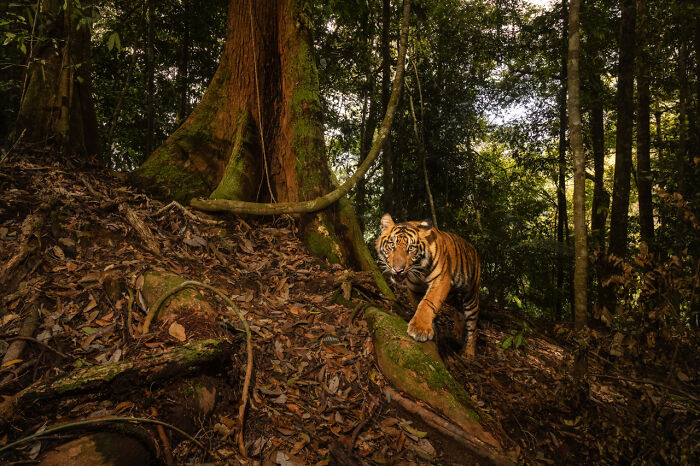
Image source: © Vladimir Cech Jr. | NPOTY 2025
“I will not exaggerate when I say that I have been waiting for this chance not for weeks, not for months, but for years. During the extreme Covid era, I decided to take a risk, overcome all the challenges that accompanied the preparations and the journey itself, and set out for my striped dream in Sumatra. For many years, I had been drawn to the idea of capturing one of the few high-resolution photos of the Sumatran tiger (Panthera tigris sumatrae), a critically endangered subspecies native to the Indonesian island of Sumatra. It is the smallest of the tigers, with stripes closer together and a darker orange coat that blends seamlessly into the tropical rainforest habitat.
I began my work there in May 2021 and returned in March of the following year to collect the remains of my equipment, mostly due to discharged batteries. I decided to leave two camera trap sets in the border zone of Gunung Leuser National Park and move the remaining two to a different area. After 315 days from installation, news came from Sumatra, both good and bad. The good: the tiger had come. The bad: it had approached from the wrong direction.
To cut a long story short, it took me more than four years to capture the gaze of one of the most amazing creatures on our planet on the display of one of my homemade camera traps. The biggest challenges were the tiger itself and the island of Sumatra. Organization and complex fieldwork are extremely demanding; you must give your absolute best, and that is only the beginning. Moisture and other natural “traps” of the rainforest can ruin your chances even a few days after installation. Everything must fit together: you need to find a great location, ensure the equipment works long enough, and hope the tiger appears. Above all, you need a huge amount of luck.”
#5 Category Mammals | Highly Commended: “In Mothers Arms” By Dvir Barkay, United States Of America

Image source: © Dvir Barkay | NPOTY 2025
“The image was captured at the La Selva Biological Research Station in Costa Rica. It is part of a series of photographs I took of this mother and her offspring, a three-toed sloth. I spent a week with the pair as they moved from tree to tree, about one tree per day, capturing thousands of images in different weather and circumstances.
In this moment, a rain shower had just begun, and the mother covered her baby as it slept, cradled safely in her embrace.”
#6 Category Fred Hazelhoff Portfolio Award | Winner: “Flowerscapes” By Theo Bosboom, The Netherlands

Image source: © Theo Bosboom | NPOTY 2025
“What would an ant see if it looked up while walking through a field of flowers? Or a ladybird resting for a moment on the stem of a flower? How fantastic would it be if you could photograph this view! Until recently, you could only dream and imagine it. But some time ago, when a long, narrow, wide-angle macro lens that can rotate 360 degrees came onto the market, photographer Theo Bosboom saw an opportunity to make that dream a reality. Bosboom said, “It was as if I had been given the key to a wonderful secret world — I felt very privileged and excited!”
It was the beginning of a personal journey of discovery through numerous flower fields and all kinds of other places where you can encounter flowers, such as roadsides, forests, dunes, and city parks, mostly in his home country, the Netherlands. The ever-surprising perspectives made Bosboom fall under the spell of flowers, and he continued to marvel at their beauty, their strength, and their fragility. The images he made for the project show flowers in a totally new way. Unlike traditional macro photographs of flowers, the emphasis is much more on the life of the flowers and the habitats they are part of.
One of the things Bosboom found very alarming while photographing was the small number of insects he encountered. In places where you would expect great insect activity, it was sometimes eerily silent. Both flowers and insects have been in serious decline in Western Europe (and many other countries) in recent decades due to intensive agriculture, urbanization, and ever-expanding infrastructure, among other factors. This is a very serious threat to biodiversity, because there is a complex ecosystem that wildflower meadows support. Fortunately, there have also been positive developments, such as the new mowing and verge management practices adopted by many municipalities in the Netherlands in recent years, with much greater attention to wildflowers and insects. But there is still a lot of work to be done.”
#7 Category Nature Art | Category Winner: “Moose In Snow” By Pål Hermansen, Norway
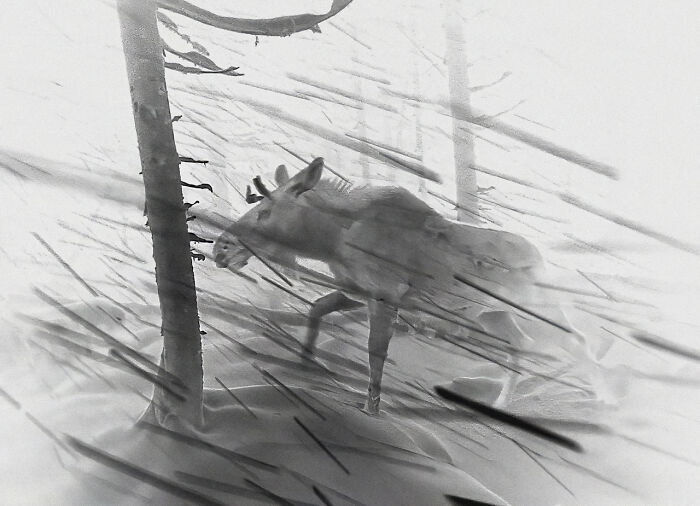
Image source: © Pål Hermansen | NPOTY 2025
“Over many years, I have set up several cameras with infrared sensors near my home in southern Norway. Usually, these are ordinary cameras placed in waterproof cases, but there are also a few trail cameras among them. One of the benefits of the trail cameras is that they feature an infrared flash, invisible to animals, and especially useful during the wintertime.
The cameras are positioned along more or less distinct trails where I expect animals to pass. Most of the time, there is nothing to see, or just false triggers, but once or twice a year, something truly interesting appears.
On this January night, a heavy snow blizzard swept through, and believe it or not, a moose passed by in the perfect pose at just that moment. Because of the wide-angle lens and great depth of field, a highly unusual image was captured with the infrared flash. I feel the rough quality of the image suits the mood perfectly.”
#8 Category Other Animals | Highly Commended: “Stranded Survivors” By Octavio Campos Salles, Brazil

Image source: © Octavio Campos Salles | NPOTY 2025
“This photograph was taken during one of the harshest droughts I have ever experienced in Brazil’s North Pantanal. What is usually a labyrinth of rivers, lagoons, and flooded plains had become a parched landscape, its lifeblood of water nearly gone. The transformation was staggering, with wetlands that should have been bursting with aquatic life reduced to cracked mud and scattered pockets of moisture.
Among the species most affected were the caimans. Normally one of the most abundant animals in the region, they now faceda crisis. Unable to disperse as they usually do, thousands were forced into the last remaining pools of mud, competing for space and survival beneath the unforgiving sun. The group in my image had once occupied a thriving wetland stretching for kilometers, now reduced to a shrinking, precarious refuge.
Anticipating these extreme conditions, I brought a drone to document the unfolding story from above. From the air, the scale of their struggle was undeniable. Dark silhouettes of caimans packed tightly together, set against a backdrop of fractured earth and drying mud, formed eerie, almost artistic patterns. The photograph captures more than just a congregation of reptiles; it is a stark portrait of resilience and vulnerability, and a reminder of the fragile balance of an ecosystem under pressure.”
#9 Category Nature Of “De Lage Landen” | Highly Commended: “Winter Wolf” By Noelle Zweers, The Netherlands
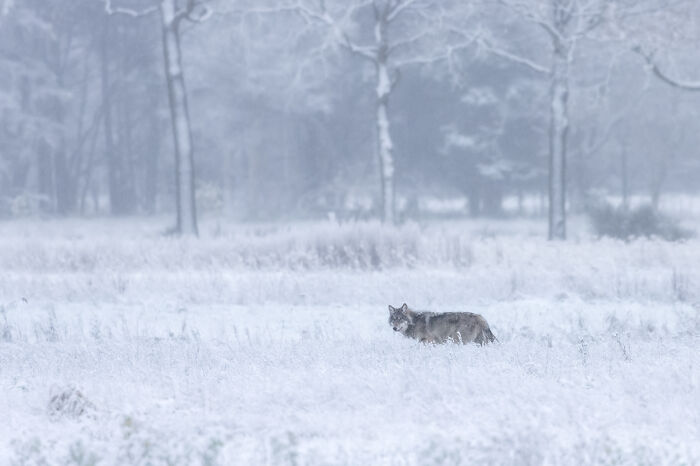
Image source: © Noelle Zweers | NPOTY 2025
“In the autumn of 2023, I heard that a young wolf had been spotted in the Drents-Friese Wold Nature Reserve, not far from my home. The wolf was visible during the day and wasn’t shy at all. After going there a few times, I finally saw the wolf for the first time in my life. We were with about six photographers, and the wolf paid no attention to us at all as it hunted for mice.
After about two hours of watching and photographing the wolf, it started snowing. The wolf continued hunting for mice even during the snowfall. At one point, it walked to the edge of the forest and eventually disappeared into the woods. The other photographers called it a day and went home. I thought, “These are such unique circumstances,” and, hoping the wolf would return, I was the only one left.
After waiting for quite some time, the snow finally stopped. My patience paid off when the wolf returned and walked across the field, which was covered in a beautiful, fresh layer of snow. What a magical feeling it was to stand there all alone and see the wolf in such a beautiful snowy landscape.”
#10 Category Animal Portraits | Highly Commended: “A Curious Nose” By Laura Dyer, United Kingdom (Country Of Origin South African)
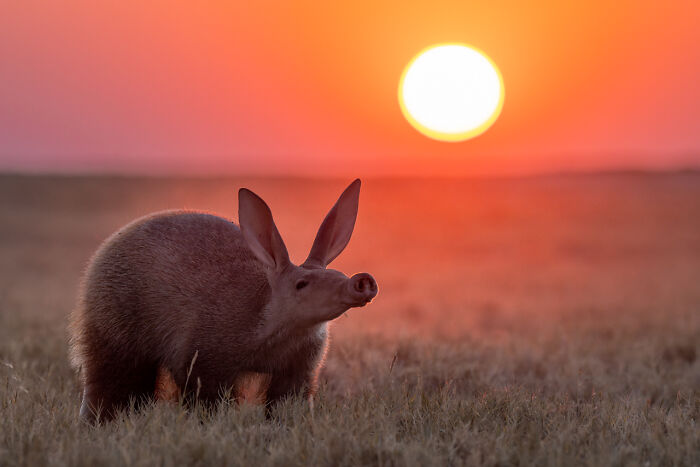
Image source: © Laura Dyer | NPOTY 2025
“One of the rarer African finds and a lifelong dream for many is seeing an aardvark. These nocturnal creatures are notoriously difficult to spot and even rarer to photograph, as they emerge under the cover of darkness to search for ants, of which they can eat up to 50,000 in one night. Feeding at night allows them to feel safer, as they are harder to spot by predators, against whom their only defence is a quick retreat into their burrow or a battle with their very sharp claws.
Aardvarks, however, are very sensitive to the cold, feeding in bursts and returning to their burrows to both digest and keep warm. On this particular visit to the Makgadikgadi Pans, a sudden cold snap in the central Kalahari meant that night-time temperatures plummeted well below zero, lower than what the aardvark can comfortably handle. This meant its nighttime feeding schedule was not long enough to meet its food requirements.
As a result, on this rare occasion, a sunset aardvark existed on Earth. He left the burrow before dark to lengthen the time he had to feed, and you can imagine my joy as I was able to spend time watching this curious-looking creature, digging for termites and using those long ears to listen intently to their underground activity. It was a truly special experience to observe an aardvark out in the open, calmly feeding and completely relaxed in our presence. It was also a once-in-a-lifetime opportunity to showcase this rare species and to see, in such sunlit detail, all that makes up one of Africa’s most remarkable mammals.”
#11 Category Landscape | Highly Commended: “In The Shadow Of The Fire” By Philipp Egger, Italy
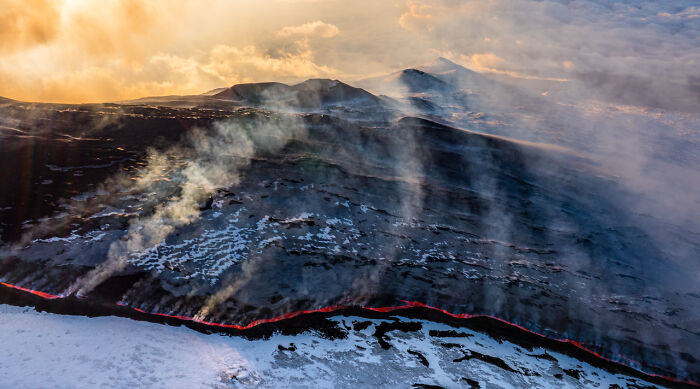
Image source: © Philipp Egger | NPOTY 2025
“With its towering 3,403 metres, Mount Etna rises as Europe’s mightiest and highest active volcano, a primordial giant whose appearance is ever changing. In winter, it seems to rest peacefully beneath a blanket of snow, a silent guardian watching over Sicily. Yet within, an untamed force seethes, ready to erupt from the depths of the earth at any moment. On this day, the mask of silence fell, and the mountain revealed its true, unbridled face.
In the early afternoon, the two of us set out to climb Etna’s slopes. A dense, high fog shrouded the mountain, swallowing the world in endless grey. With every step, the air grew heavier, laced with the sharp scent of sulphur. The wind drove smoke and acrid gases into our faces, as if the volcano itself sought to bar our way. Still, we pressed on, step by step, until by evening we reached nearly 3,000 metres, a place where the raw power of the mountain unfolded in all its might.
At the foot of the Southeast Crater, a massive fracture had opened, a gaping wound from which liquid fire burst forth. A torrent of glowing lava rolled relentlessly down the snow-covered slopes, as though the mountain were laying bare its very core. For days, the lava flowed until, at about 1,800 metres, it froze in the icy air, a hardened ribbon of fire testifying to the tireless, hidden energy within Etna.
With the first light of the following day, a breathtaking sight was revealed. The sun rose behind the old, long extinct craters, silent witnesses to eruptions more than twenty years past. Its golden rays cast the rising smoke and thick fog into a shimmering play of colours. The landscape itself was divided, like a mirror of the volcano’s contrasts. One side snow white, the other blackened by ashfall and the west winds of recent days, etched with fine dark lines drawn by the storm across its surface.
Etna is more than just Europe’s highest active volcano; it is a being in constant transformation, forever reshaping its form. Few places so vividly display the earth’s raw power and the transience of all things. Every eruption is a spectacle of nature that inspires awe, a wonder that never ceases to astonish and remind us to pause in reverence.”
#12 Category Underwater | Runner-Up: “Jellyfish Watercolour” By Alex Varani, Italy

Image source: © Alex Varani | NPOTY 2025
“While diving on the reef off Misool Island, Indonesia, I encountered a mass aggregation of jellyfish from the Pelagiidae family (cf. Pelagia noctiluca or Sanderia malayensis). Thousands of these creatures drifted with the gentle current just a few meters from the reef wall.
These dense swarms, known as “blooms,” occur when jellyfish gather near the surface and coastal areas. Blooms are favored by specific environmental conditions and can be accompanied by increased reproduction, resulting in a greater abundance of individuals. The phenomenon is striking, as these jellyfish have a notable sting and can cause panic for those who encounter them.
Being naturally very curious, I approached the bloom as closely as possible without disturbing it and managed to capture the photo in one of the areas with the highest concentration. The resulting image resembles a delicate watercolor of jellyfish.”
#13 Category Underwater | Highly Commended: “Newt Embrace” By Anton Sorokin, United States Of America

Image source: © Anton Sorokin | NPOTY 2025
“Every spring, California newts (Taricha torosa) return to ponds to breed. Over the years, photographing them has become one of my favorite subjects. From above, this particular pond in the San Francisco Bay region of California doesn’t look like much; it is a muddy pool nestled between gently rolling hills, sometimes used as a latrine and watering hole for local cattle. Yet underwater, it pulses with amphibian activity. Female newts lay eggs, while others attempt to eat them. Male newts pursue potential mates, grabbing onto both females and other males. Males are quickly released, but when a male finds a female, he grips tightly, and for good reason: rival males soon join the fray, attempting to pry him off. It can be difficult to tell where one newt ends and another begins. Eventually, the winning male and female break away and flee the other males. On this occasion, the sun was low, and by adjusting my angle, I was able to include it over the pair of newts in amplexus.”
#14 Category Human And Nature | Highly Commended: “The Long Journey” By Joan De La Malla, Spain
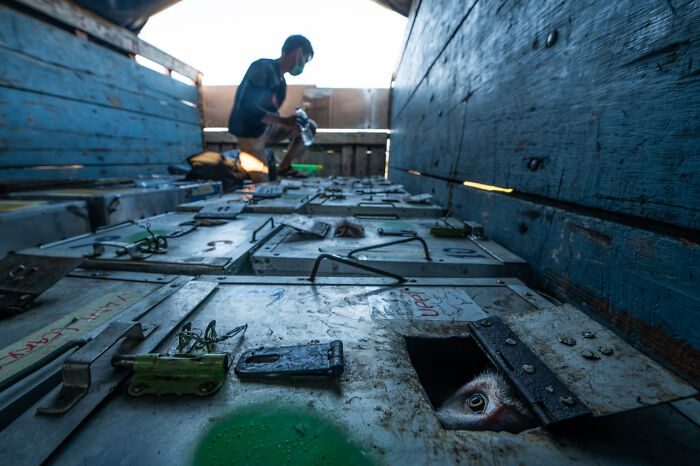
Image source: © Joan de la Malla | NPOTY 2025
“A macaque peers out from its transport box, trying to observe what happens outside during its journey to be reintroduced into the wild.
In some cities of Java, Indonesia, there is a practice known locally as Topeng Monyet. It involves the use of trained macaques in street performances. These macaques are often harshly trained and live a frightening, lonely life, deprived of the social bonds that primates deeply depend on. The practice is, in fact, illegal, and many macaques are now being confiscated and rehabilitated. When they arrive at the facilities run by the Jakarta Animal Aid Network, they receive the care and attention they need. After many months of rehabilitation, the macaques are ready to be reintroduced. Their long journey back to freedom takes many days and requires several different forms of transport.”
#15 Category Other Animals | Category Winner: “Silent Scream” By Bence Máté, Hungary

Image source: © Bence Máté | NPOTY 2025
“I am grateful for every moment my work allowed me to spend on Bird Island, part of the Seychelles, a tiny island of two kilometres in width made of coral sand. Its wildlife, atmosphere, and overall essence were so vastly different from what I was accustomed to back home that I felt as if I had stepped into a parallel world.
The island is privately owned, and thanks to the dedicated efforts of its caretakers, the last rat, introduced by humans, was eradicated in the 1980s. Combined with controlled vegetation management, this has allowed the island to become home to more than seven hundred thousand pairs of sooty terns today. However, I arrived outside their breeding season and saw only a handful of individuals, though other bird species were still nesting, even in November.
While waiting to photograph white terns, I suddenly heard a distress call. Not far from me, an adult brown noddy was tormenting a helpless chick of its own species for reasons I could not understand. Within moments, the struggling chick, now lying defenseless on the ground, was swarmed by crabs that began devouring it alive. It was heartbreaking to witness, but I chose not to interfere with the natural order.
In no time, nearly ten crabs had surrounded the chick, dragging it into the bushes, one of nature’s rawest moments, a silent scream lost in the vastness of the island.”
#16 Category Underwater | Category Winner: “Featherhome” By Luis Arpa Toribio, Spain
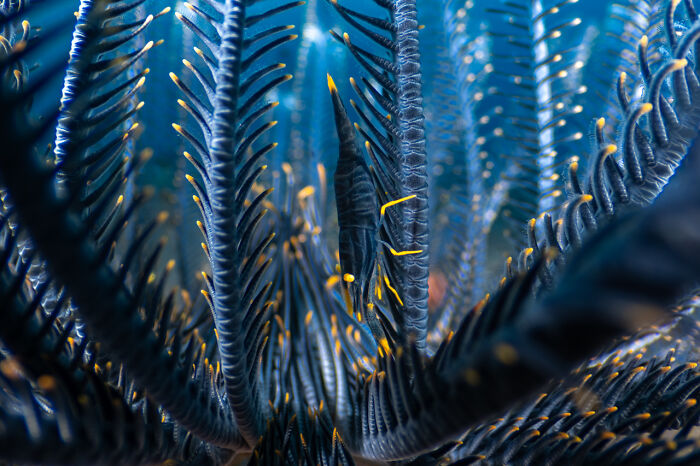
Image source: © Luis Arpa Toribio | NPOTY 2025
“I’ve always been fascinated by the smallest creatures of the reef, those that most divers overlook. For a long time, I had imagined photographing these tiny critters from their own perspective, to show what their miniature world might look like if you were right there with them.
In Tulamben, Bali, while exploring feather stars, I came across a crinoid shrimp (Laomenes amboinensis). Perfectly camouflaged in both color and pattern, it clung tightly to its host, spending most of its time motionless and relying on the feather star for protection as well as for food drifting in the current. Normally, such shrimps disappear into their surroundings, but with the help of a “bug-eye” wet lens, I was able to get very close while still keeping most of the crinoid in frame.
That unusual perspective gave exactly the feeling I was hoping for, a view that pulls you inside the shrimp’s fragile, hidden world, where beauty and survival depend entirely on blending in.”
#17 Category Nature Art | Runner-Up: “Injured Guillemot” By Knut-Sverre Horn, Norway

Image source: © Knut-Sverre Horn | NPOTY 2025
“I thought the guillemot was about to die when I found it lying still on the ground, partly covered in blood running from its right eye, on Hornøya, Varanger, Northern Norway. An hour earlier, I had been quite annoyed to realize that my brand-new macro lens was still in the camera bag, as I don’t like to haul around more gear than I’ll actually use. Now, the lens came in handy after all. The drops of blood made a striking contrast against the dark brown and white feathers.
I kneeled down and took a few photos with different framings and angles when the bird suddenly took flight. It was apparently able to see me with its left eye. I don’t know what caused the injury, but guillemots may fight fiercely, and I have also seen them collide mid-air when they circle the colony in huge swarms. Hornøya is one of my favourite places, and I take ninety-nine percent of my images close to my home in Varanger.”
#18 Category Mammals | Highly Commended: “No Fear, No Mercy” By Tomasz Szpila, Poland
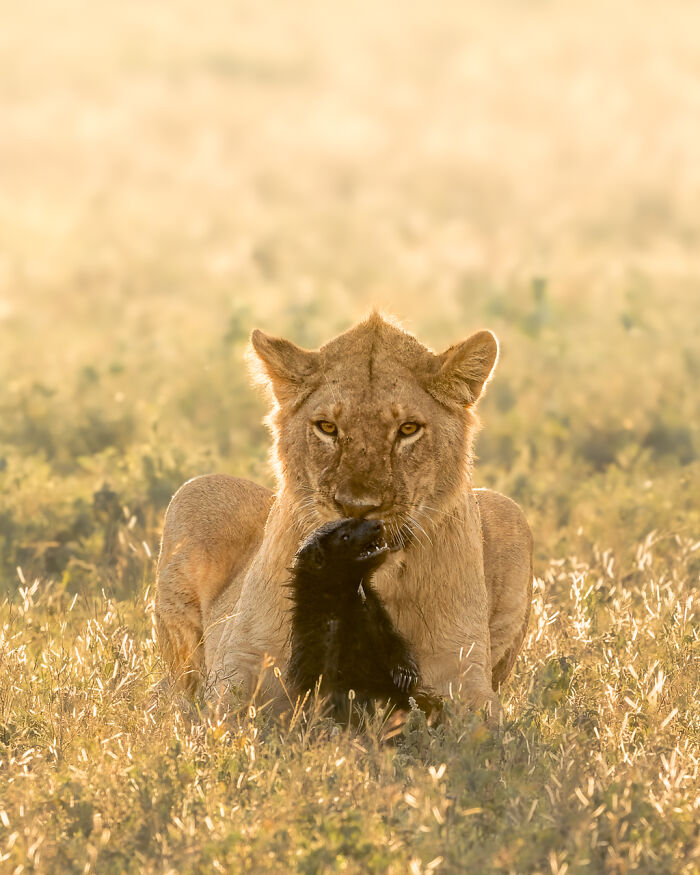
Image source: © Tomasz Szpila | NPOTY 2025
“Some of Africa’s most fascinating animals are not its largest, but its smallest warriors. Among them, the honey badger (Mellivora capensis) has earned a reputation for unmatched courage and determination. Despite its modest size, this fearless predator can fend off much larger adversaries, often attacking with surprising aggression and stamina. Protected by exceptionally tough skin and a natural resistance to bites and stings, honey badgers have the tools to survive encounters that would doom most other animals. Yet, as with all creatures, youth and inexperience can tip the scales, making young individuals especially vulnerable to apex predators such as lions.
It was early one morning on the open plains near Lake Ndutu, in the southern Serengeti ecosystem, that I witnessed a dramatic and rare confrontation between these two iconic species. A young lion, full of energy and curiosity, had managed to corner a honey badger. At first glance, the scene appeared almost playful: the lion pawing, circling, and testing its opponent, as if enjoying a game. But for the honey badger, the reality was far from a game. Exhausted, breathing heavily, and with limited options for escape, it summoned all its strength and ferocity in a desperate attempt to resist.
Watching the two locked in this uneven battle was a stark reminder of the harsh realities of the natural world. The honey badger’s legendary reputation for fearlessness was on full display; it snapped, lunged, and refused to submit, even in the face of overwhelming odds. The young lion, however, held the advantage in both size and stamina, gradually wearing its opponent down. This time, the outcome was clear: the lion prevailed, asserting dominance over one of Africa’s most resilient fighters.
Encounters like this highlight the constant struggle for survival on the savanna, where even the fiercest spirit cannot always overcome sheer strength. In the end, the bravery and tenacity of the honey badger serve as a powerful symbol of wild resilience, but they also remind us that courage alone is not always enough to defeat a much stronger adversary.”
#19 Category Birds | Category Winner And Overall Winner: “Sundance” By Åsmund Keilen, Norway
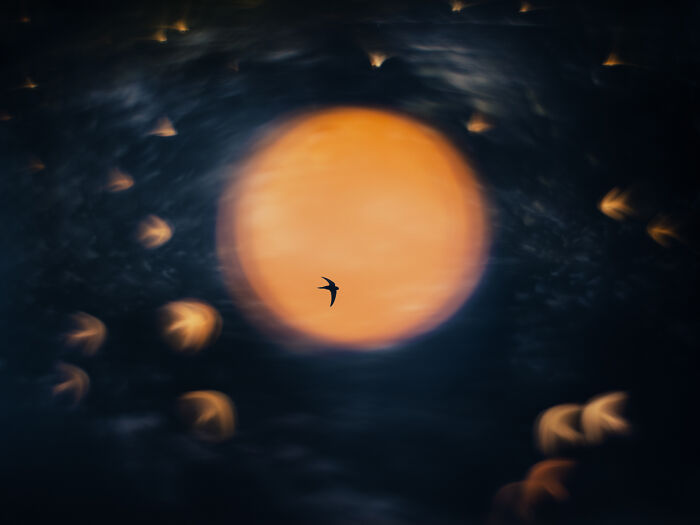
Image source: © Åsmund Keilen | NPOTY 2025
“The photo was taken just outside Oslo on a hot summer day. I was on my way to the store to buy food. I have a habit of leaving my coffee cup on the roof of my car when unlocking our old blue Mercedes, and more than once I’ve forgotten it there and driven away.
That day, when I backed out of the driveway, the cup tipped over but somehow stayed on the roof. A little discouraged, I reached to pick it up – and immediately saw what would become this photograph. Small orange birch seeds had fallen onto the blue roof during the night, and the summer sun reflected alongside dancing common swifts in the sky. Freedom seemed to take form in chaos.
With the help of in-camera multiple exposure, I was able to recreate what I saw and felt that day: an impression of a reflection – or perhaps a reflection of an impression.”
#20 Category Black And White | Highly Commended: “Tails And Paws” By Dvir Barkay, United States Of America
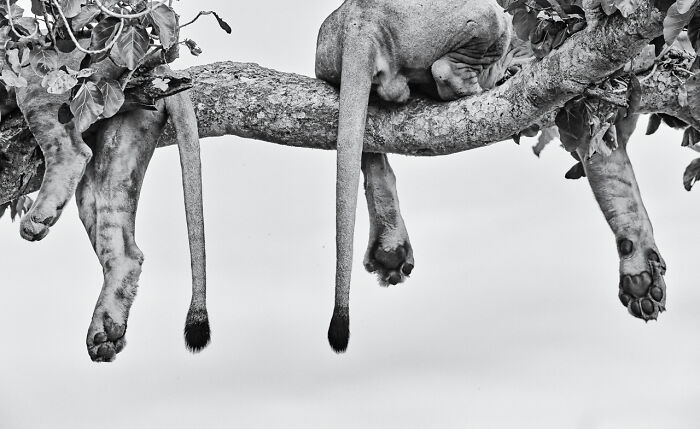
Image source: © Dvir Barkay | NPOTY 2025
“The image was captured in the Ishasha sector of Queen Elizabeth National Park in Uganda. We found the famous tree-dwelling African lions of the Ishasha sector early in the morning and spent a good portion of the day with them. The lions frequently changed positions as they rested in the trees, and at one point, the male turned his back on the female. With their tails and paws hanging lazily below them, I was able to capture this image.”





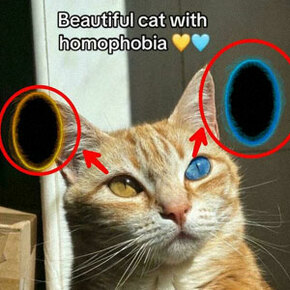






Got wisdom to pour?